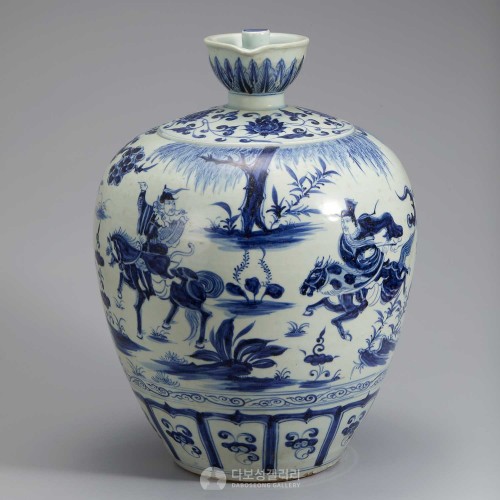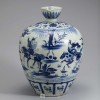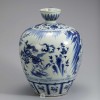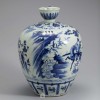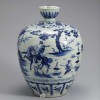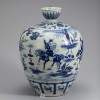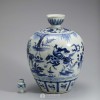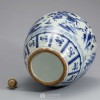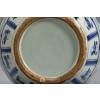본문
수(隋, 581-619)나라 말기에 열여덟 차례 일어난 농민봉기 때 중원에서 세 명의 명장, 즉 정양(定陽)의 유무주(劉武周), 낙양(洛陽)의 왕세충(王世忠), 태원(太原)의 이연(李淵)이 격돌하는 장면을 청색 안료로 그린 삼명장문(三名將紋) 항아리입니다.
세 장수가 각각 말을 타고 서로 쫓고 쫓기는 모습이 역동적입니다.
어깨에는 여러 방향의 꽃잎들이 층층이 중첩된 모양의 보상화(寶相花) 무늬가 상서로운 날을 기원하는 의미로 그려져 있습니다.
어깨가 크게 부풀어졌다가 굽으로 갈수록 좁아지는 기형입니다.
구연부에 마개가 있고 홈이 있는 것으로 보아 식초병으로 사용된 것으로 추정됩니다.
영락(永樂)은 반란으로 집권한 명나라 제3대 황제 주체(朱棣)의 연호입니다.
영락제(재위 1403~1424)는 정력적인데도 문무를 겸비해 홍무제 때 벌인 몽골족과의 전투에서 승리했으며, 1421년 자신의 권력기반인 베이징으로 천도했습니다.
영락제의 치세는 중국 역사에서 가장 찬란한 시대로 꼽힙니다.
이 시기의 1405~1433년에 이슬람교도 정화(鄭和)의 남해원정이 이루어져 페르시아에서 코발트 안료가 수입되어 청화(靑花) 백자 기술이 크게 발달했습니다.
隋朝(581-619年)末期在中原发生过18次农民起义时,其中的三位名将,即定阳的刘武周、洛阳的王世忠、太原的李渊发生激烈冲突的场景,该罐用蓝色颜料绘于外壁。
三名将帅各自骑马互相追逐的样子,生动活泼。
肩部层层叠着各种方向花瓣的宝相花图案,具有祈愿吉祥日子之意。
丰肩,肩以下渐收。
从口沿部有塞子和槽的情况来看,推测是用作醋瓶。
永乐是因叛乱而执政的明朝第三代皇帝主体的年号。
永乐帝(1403~1424在位)虽然精力充沛,但文武兼备,在洪武帝时期与蒙古族展开的战斗中取得了胜利,并于1421年迁都到了自己的权力基础北京。
永乐祭的治世堪称中国历史上最灿烂的时代。
这一时期的1405~1433年,伊斯兰教徒郑和的南海远征得以实现,从波斯进口钴颜料,青花白瓷技术大幅发展。
━━━━━
It is a jar of Sammyeongjangmun, which depicts the clash of three masters, Yu Yu-ju of Jeongyang, Wang Se-chung of Nakyang, and Lee Yeon of Taewon, in blue pigment during 18 peasant uprising at the end of the Sui Dynasty.
It is dynamic to see the three generals riding horses to chase and chase each other.
On the shoulder, the compensation flower pattern, in which petals in various directions are overlapped, has a meaning of wishing for an auspicious day.
It is a deformity in which the shoulders are greatly inflated and then narrowed toward the heel.
It is presumed to have been used as a vinegar bottle, considering that there is a stopper and a groove in the mouth.
Yeongrak is the name of the third emperor Juche of the Ming Dynasty, who came to power in rebellion.
Yeongnakje (r. 1403-1424) won the battle against the Mongols during the Hongmuje Festival, despite his energy and civil affairs, and moved to Beijing, his power base, in 1421.
The reign of Yeongrakje is considered the most brilliant period in Chinese history.
During this period, from 1405 to 1433, Islamic Jeonghwa's expedition to the South Sea was carried out, and cobalt pigments were imported from Persia, and the technology of blue and white porcelain was greatly developed.
